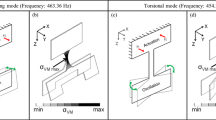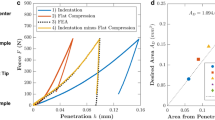Abstract
This paper describes the design, modeling, and experimental test results of a single crystal silicon micromechanical device developed to evaluate fracture and fatigue of silicon based micromechanical devices. The structure is a cantilever beam, 300 microns long, with a large silicon plate and gold inertial mass at the free end. Torquing and sensing electrodes extend over the plate, and with associated electronics, drive the structure at resonance. Fatigue crack propagation is measured by detecting the shift in the natural frequency caused by the extension of a preexisting crack introduced near the fixed end of the cantilever. Experimental data are presented demonstrating time-dependent crack growth in silicon. Crack extensions of 10 to 300 nm have been measured with a resolution of approximately 2.5 nm, and crack tip velocities as low as 2.1×10−14 m/s. It is postulated that static fatigue of the native surface silica layer is the mechanism for crack growth. The methodology established here is generic in concept, permitting sensitive measurement of crack growth in larger fatigue specimens as well.
Similar content being viewed by others
References
Bhaduri, S.B. and Wang, F.F.Y., “Slow Crack Growth Studies in Silicon,” Fracture Mechanics of Ceramics, Chap. 5, 327–336, Plenum Press (1983).
Broek, D., Elementary Engineering Fracture Mechanics, Nijhoff Publishers, 139, (1986).
Chen, C.P. and Leipold, M.H., “Crack Growth in Single Crystal Silicon,” NASA Tech. Brief,10 (3)Item no. 106, National Aeronautics and Space Administration, NASA Technology Transfer Div., PO Box 8757, BWI Airport, MD 21240 (May/June 1986).
Chen, C.P. andLeipold, M.H., “Fracture Toughness of Silicon,”Amer. Cer. Soc. Bul.,59 (4),469–472 (1980).
Chen, T.J. and Knapp, W.J., “The Fracture of Single Crystal Silicon Wafers Under Several Liquid Environments,” J Amer. Cer. Soc.—Discussion and Notes (March–April 1980).
Ewart, L. andSuresh, S., J. Mat. Sci.,22,1173 (1987).
Fan, L.S., Tai, Y.C., and Muller, R.S., “Pin Joints, Gears, Springs, Cranks and Other Novel Micromechanical Structures,” Int. Conf. on Solid State Sensors and Actuators, 849–852, Tokyo, Japan (1987).
Griffen, W.S., Richardson, H.H., andYamanami, S., “A Study of Fluid Squeeze-film Damping,”Trans. ASME,88 (D),451–456 (June 1966).
Hong, S., Weihs, T.P., Bravman, J.C., andNix, W.D., “Measuring the Strength and Stiffness of Thin Film Materials by Mechanically Deflecting Cantilever Microbeams,”Thin Films: Stresses and Mechanical Properties, Materials Research Society,130,87–92 (1989).
Johansson, S. andSchweitz, J., “Fracture Testing of Silicon Microelements in situ in a Scanning Electron Microscope,”J. Appl. Physics,10 (63),4799–4803 (May 15,1988).
Michalske, T.A. andFreeman, S.W., “A Molecular Mechanism for Stress Corrosion in Vireous Silica,”J. Amer. Ceramic Soc.,66 (4),284–288 (1983).
Murakami, Stress Intensity Factors Handbook, Pergamon Press,1,11 (1987).
Sadd, M.H. andStiffler, A.K., “Amplitude Effects at Low Squeeze Numbers,”J. Eng. for Ind. 97 (B),1366–1370 (Nov. 1975).
Thouless, M.D. and Cook, R.F., Phys. Lett.,56 (1962).
Vander Velde, W.E. and Gelb, A., Multiple-Input Describing Functions and Nonlinear System Design, McGraw Hill (1968).
Wiederhorn, S.M., “Subcritical Crack Growth in Ceramics,”Fracture Mechanics of Ceramics, Chap. 2, pages 613–646, Plenum Press, New York, (1974).
Wise, K.D. andNajafi, K., Science,1335,254 (1991).
Wong, D., and Holbrook, R.J., “Microindentation for Fracture and Stress Corrosion Cracking Studies in Single Crystal Silicon,” J. Electromechemical Soc., (Sept. 1987).
Author information
Authors and Affiliations
Rights and permissions
About this article
Cite this article
Connally, J.A., Brown, S.B. Micromechanical fatigue testing. Experimental Mechanics 33, 81–90 (1993). https://doi.org/10.1007/BF02322482
Received:
Revised:
Issue Date:
DOI: https://doi.org/10.1007/BF02322482




